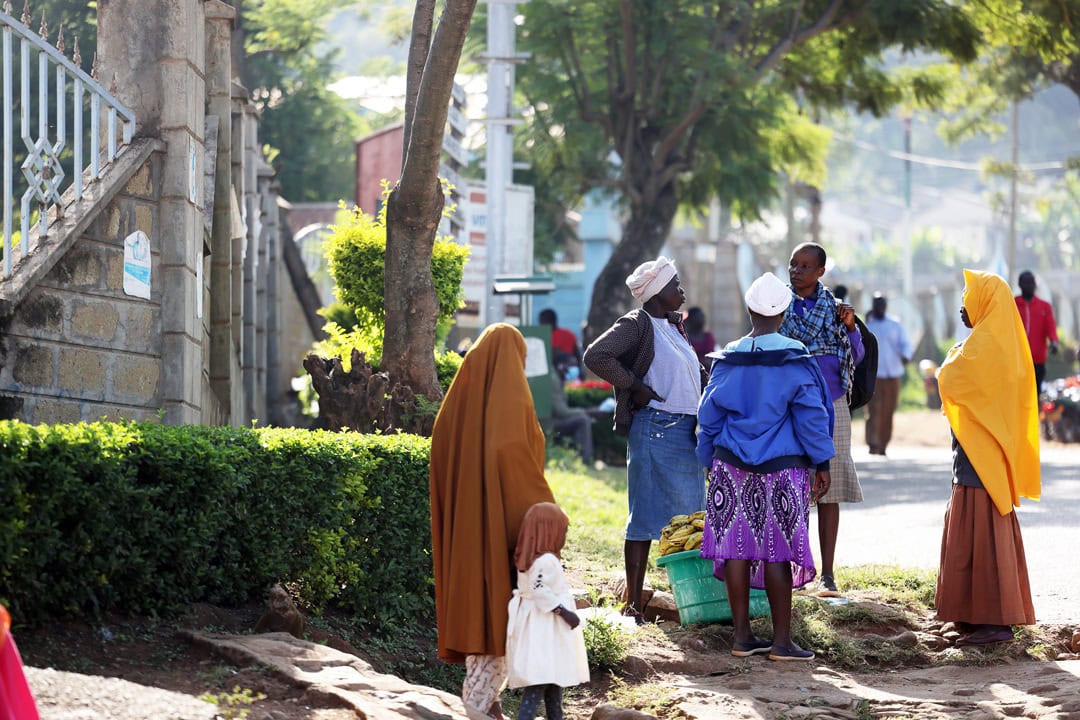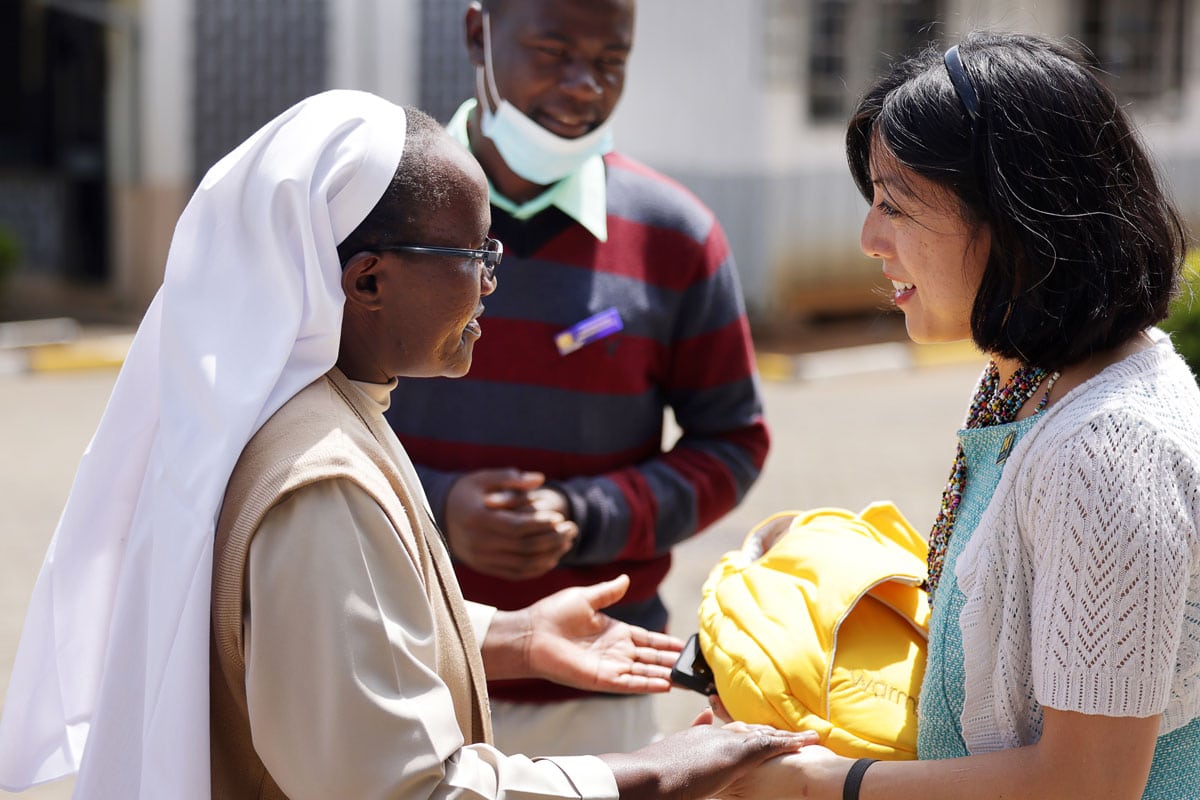
Warmed by science. Powered by love.
12 years and thousands of miles later, Grace Hsia Haberl’s student project is still changing the world—one preemie at a time.
PHOTOS BY: Brenda Ahearn
Contents:
When the pain started, it never occurred to Edna Salome that her baby might be coming. After all, she was only seven months pregnant and her other two children had both been full-term. But to be safe, the 34-year-old hitched a ride on a neighbor’s motorbike to Kehancha Sub-County Hospital, about two miles from her home in Kenya’s Kehancha Town, a fast-growing but largely rural city of around 250,000 people. She thought she’d make sure all was well and perhaps get some pain medication for her cramps.
“When I found that the baby was coming, it was a shock,” she said. “I knew it wasn’t right. It was too early.”
Being just 30 weeks pregnant, Salome hadn’t brought baby clothes. As is common in Kenya, her husband lives near his job in Kisii, more than two hours north. Her two other children were away at boarding school. And the hospital was in the midst of a power outage, its backup generators nearly out of diesel fuel.
Despite those difficulties, baby Adrian Jr. arrived quickly, weighing in at just over 3 pounds. In addition to being dangerously small, he had respiratory distress and required oxygen. He would also need help maintaining a viable body temperature. Pre-term babies are at high risk for hypothermia because they have very little body fat, and they lack the temperature-regulation capabilities—like shivering—of full-term babies. They can spend days to months in incubators for that reason.

Without electricity, the maternity ward would soon lose the ability to provide Adrian with oxygen. He would need to go to Migori County Referral Hospital, a long, cold ambulance ride away. Salome was distraught.
“The baby was underweight and had low blood pressure—it was overwhelming,” she said.
The nurses did their best to reassure her, making sure she knew that pre-term births are risky but common. The key is to keep the baby warm.
They wrapped Adrian in what looked like a preemie-sized sleeping bag with a plastic pack inside. This IncuBlanket, they said, would help keep him safe and warm, no electricity required.
“When they told me about the IncuBlanket,” Salome said, “it was such a feeling of relief and hope that he would survive.”
The technology behind that non-electric warming device was born in 2011 in a materials science and engineering capstone class on U-M’s North Campus. Grace Hsia Haberl (BSE MSE ’12, MsE ’13), then a senior at Michigan Engineering, was part of a team that developed a prototype device to keep premature babies warm without electricity.
Other students might have let the project fade into a line on a resume. But after finishing her bachelor’s, Hsia Haberl discovered that she couldn’t let it go. She co-founded a startup called Warmilu™ and spent the next 12 years pushing the company forward.
“I was going to be an intellectual property lawyer,” she said. “I literally took the LSAT, applied to law school, got an interview at the College of William and Mary and realized in that moment that I wanted to keep working on my startup.”
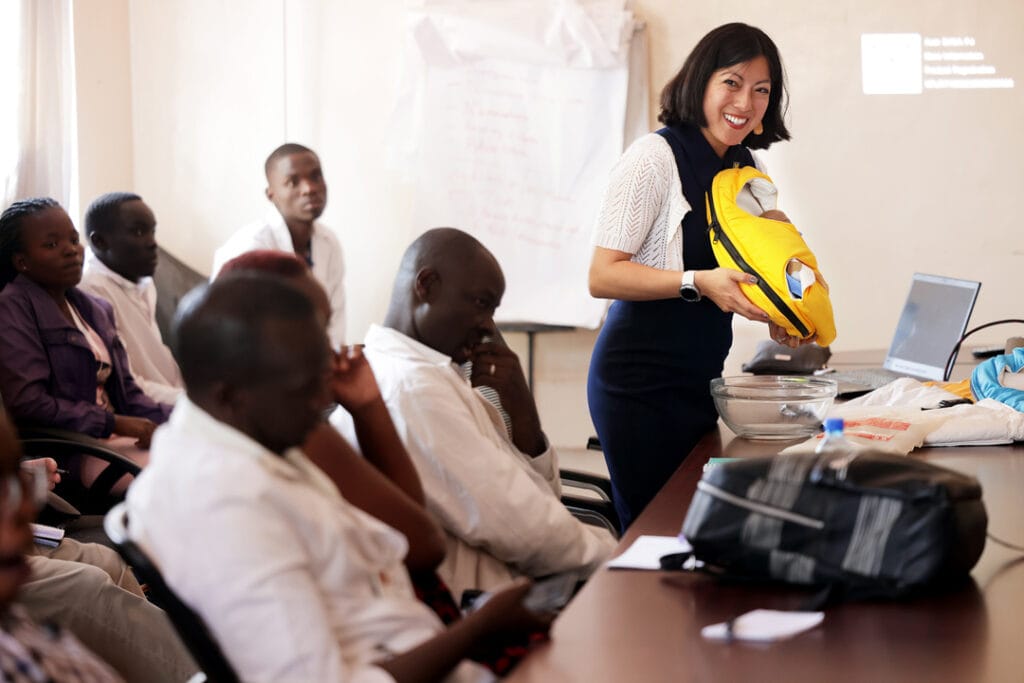
She transformed herself from a shy, bookish student into a savvy networker and deal-maker, combining her engineering fundamentals with a degree from the Master of Entrepreneurship program run jointly by Michigan Engineering and the Stephen M. Ross School of Business. She traveled the world to hear from healthcare providers and conduct field testing, taught herself to sew and became fluent in supply chain management, neonatal health and radiofrequency welding, among other fields.
Hsia Haberl built Warmilu into a system that not only saves babies, but also generates educational opportunities for U-M students. Today, she’s a full-time lecturer in the U-M Center for Entrepreneurship, and she makes it a point to share the knowledge and experience she gleans from Warmilu with her U-M students. She also teaches summer entrepreneurship classes to Detroit high school students through U-M’s NAF Future Ready Scholars program and coaches small businesses as the co-director for entrepreneurial programming at the Advanced Materials and Manufacturing Program (AMMP) Accelerator in Michigan’s Upper Peninsula. For her, bringing knowledge back home is a key part of her company’s mission.
A CIRCLE OF CARE
In the early days of Warmilu, Hsia Haberl discovered that there’s no substitute for face-to-face meetings with patients, customers and medical experts. For starters, there’s no better way to make sure that technology designed in the United States will be useful and practical in a different health system and culture. In-person visits also build trust, and Kenyans in particular place a high value on personal connections and courtesy. And because most medical professionals are unfamiliar with Warmilu’s non-electric warming technology, a live demonstration can create a wow factor like nothing else.
Warmilu does the majority of its business in Kenya, and Hsia Haberl has made it a sort of home away from home, visiting again and again to gather feedback from current customer hospitals, meet with new prospects and distributors and, occasionally, to research potential collaboration opportunities between Kenyan educational and government entities and U-M.
The two-week trip documented here was Hsia Haberl’s first since the pandemic.
“There’s nothing like sharing these real-world stories from the field to really inspire students—whether it’s how important it is to talk to stakeholders, how important it is to get continuous feedback or how important it is for students themselves to get hands-on experience,” she said. “And when they hear those stories, when they see these photos, when they can see—reflected in those design and innovation conversations—stakeholders who look like them, who talk like them, it’s like a spark goes off in their head.”
In addition, Hsia Haberl hopes that her company will soon become a source of jobs in the countries where its products are used. By working with local entrepreneurs to set up a network of in-country shops to sew Warmilu’s blankets, she hopes to both create jobs and make the blankets more affordable to the medical facilities that need them.
“
There’s nothing like sharing these real-world stories from the field to really inspire students.
Fueling Hsia Haberl’s determination is the fact that, like Adrian, she was a preemie who depended on a warming technology early on—for the first 11 days of her life.
“If it wasn’t for an incubator, I would have died on day zero,” Hsia Haberl said. “So I felt like developing this technology was my way of giving something back, to bring things full circle.”
Bundled into an IncuBlanket, Adrian survived the long ride to Migori. He left the hospital 29 days later, healthy and gaining weight.
A life-changing reaction
Back in Hsia Haberl’s undergrad days, she and her capstone project teammates had learned that hypothermia is a persistent problem among pre-term infants, particularly in under-resourced settings. A 2016 study in The Lancet found it to be the most common contributory cause of pre-term death, factoring into nearly 70% of them. The National Institutes of Health calls hypothermia an “underappreciated major challenge for newborn survival in developing countries … It contributes to a substantial portion of neonatal mortality globally.”
In wealthy countries, pre-term babies are generally kept warm in incubators. But incubators are expensive, and in less well-off countries, access can be limited and a power outage can quickly render them useless. Many mothers give birth in remote areas far from hospitals, and even when advanced care is available, it often requires a lengthy trip to a major city.
WARMILU
BY THE NUMBERS
11,000
babies warmed each year
1,000
IncuBlankets produced
23
Countries
85
Healthcare systems
5-8 hours
of heat per charge
100
charges
per warming pack
100
USD
per IncluBlanket (and falling)
3 sizes
of IncuBlanket, for babies from birth to 4 months
The U-M student team was familiar with a non-electric warming technology used in devices like seat cushions and hand warmers. It relies on a phase-change reaction in a solution of sodium acetate trihydrate, storing heat as its crystals melt into liquid and releasing it later with the click of a metal disc. But the devices get far too hot for infants, and their heat isn’t consistent enough for a medical device.
“In the earliest days, our biggest challenge was ‘How do we make a device that will never, ever burn a baby,’” Hsia Haberl said.
After a series of thermal and CAD simulations and dozens of iterations with different materials and proportions, the team made a breakthrough. They discovered that adding petroleum jelly to the sodium acetate trihydrate solution can moderate the phase change reaction, slowing and prolonging the release of heat. Just the right amount of jelly can dial in just the right temperature—in this case, between 98.6 and 100.3 degrees Fahrenheit.
They developed a plastic warming pack that consistently delivers the right amount of heat and a blanket that focuses and distributes that heat in just the right way to safely keep a baby’s temperature where it needs to be. Nestled inside the blanket, the pack can keep a single newborn comfortable for 5-8 hours in a hospital, or, in an ambulance, it can warm multiple babies on shorter trips.
With the basic technology in hand, Hsia Haberl enrolled in the Entrepreneurship Master’s Program, which helped her co-found Warmilu to commercialize and scale up the final product. Warmilu ultimately patented the mix of materials that enables the safer phase-change reaction and acquired FDA approval for the IncuBlanket as a certified medical device.
The master’s program also connected Hsia Haberl with experts that helped the company refine its distribution model. In addition, faculty there matched Warmilu with U-M-connected hospitals in India and Kenya, where field testing helped to make the IncuBlankets useful in real-world clinical settings.
Where IncuBlankets come from


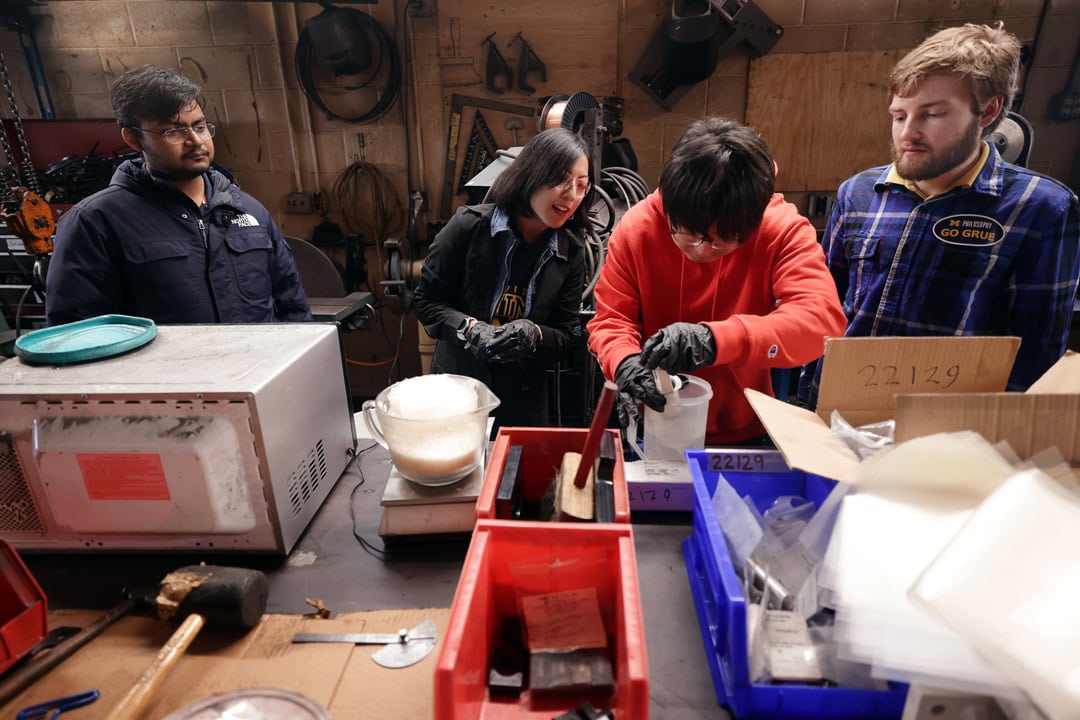
In June 2023, around the time baby Adrian came home to meet his family and neighbors in Kehancha Town, Hsia Haberl gathered with a group of her students in a garage tucked behind a towering red brick Victorian near the corner of Ashley and Liberty in Ann Arbor. The garage is the birthplace of every Warmilu warming pack, including the one that helped Adrian.
Warmilu shares the rented space with an outfit that machines precision prototypes for the military, and it’s dominated by their lathes and drill presses. It’s also home to Marla, the radio frequency welding machine that seals Warmilu’s packs shut, as well as a collection of old microwaves, a brightly chromed machine that dispenses dry chemicals and metal shelves piled with Tupperware and Pyrex containers. There’s a palpable tinge of grease in the air. Classic rock plays from a radio stashed somewhere in the jumble of tools and machinery
Out pops Hsia Haberl from behind the 10-foot-tall welding apparatus. “The machine’s on!” she calls, then dashes outside. She returns a few seconds later, lugging an enormous blue plastic barrel of powdered sodium acetate trihydrate.
During the summer, Hsia Haberl generally spends at least one day a week making warming packs, recruiting student volunteers to work with her. She can use the help, and she also believes it’s important for students to get hands-on production experience—to see for themselves how a manufacturing process works. In a sense, the garage is a classroom as well as a manufacturing facility.
“I think experiential learning spaces are so important—students can generate amazing technologies, they’re so technically savvy and smart,” she said. “We just need to give them the right tools to nurture that seed of innovation.”
Today she’s joined by Entrepreneurial Leadership Program undergraduate and Warmilu summer intern Jooyoung Chung, as well as mechanical engineering master’s student Erin Donnelly and Ross School of Business MBA student Vraj Mehta. A few weeks from now, the warming packs they make will travel with Hsia Haberl and Chung to Kenya, where Warmilu does the majority of its business.
“Kenya is a great place for innovation,” Hsia Haberl said. “Talking to doctors, nurses and county health officials, we got really good honest feedback that led to rapid prototyping and, ultimately, our final clinical product.”
Chung is a pack-making veteran, but Donnelly and Mehta are newbies, so Hsia Haberl walks them through the process. It starts with great globs of petroleum jelly, troweled out of a white plastic bucket, weighed on a digital scale and plopped into a giant Pyrex dish.
Next, sodium acetate trihydrate is added—the food-grade powder is the same ingredient that gives salt-and-vinegar potato chips their kick. The mixture, along with a little water, then goes into the microwave. When it comes out, everything is melted together and the hot, clear liquid is ready to be poured by hand into a waiting plastic pack, which is made by Warmilu in the same facility.
Hsia Haberl shows Donnelly how it’s done, deftly lifting and tilting the dish so the liquid flows through a black plastic funnel. She massages the pack to excise any air. “Bubbles are not our friend,” she explains, peering intently through the clear plastic.
After the liquid is in, it’s Marla’s turn. Hsia Haberl salvaged the towering, press-like machine from a Motorola phone factory. It once sealed the impossible-to-open plastic clamshell packs that fill the shelves of big-box stores. Hsia Haberl gave it a second life and hired a radio frequency welding engineer to teach her how to keep it running.
“She’s an old machine, and sometimes she has aches and pains, but she seals all our packs,” Hsia Haberl said. “Bless you, Marla.”
Chung does the honors, pressing Marla’s buttons as the top plate lowers onto the pouch with a pneumatic hiss. The pack is done and ready for its journey to Kenya.
Hsia Haberl walks Victor Adika through the steps of sewing an IncuBlanket at Adika’s shop, Adiva Fashions, located in Nairobi’s Hurlingham neighborhood.
Blankets that build futures
A few weeks later in Kehancha Town, Adrian has grown to just over 5 pounds—still worryingly small but hungry and heading in the right direction. Hsia Haberl is in Nairobi, just 200 miles away, in a rented minivan crawling through the city’s infamous traffic. The warming packs from the garage are stuffed into a suitcase in the back.
While the pack is critical to every IncuBlanket, it’s only part of the system. There’s also the blanket, a carefully designed medical device that combines a variety of fabrics and strategies to distribute and maintain heat.

Born to warm
Travel to Kenya with Grace as she shares her University of Michigan-born non-electric infant warming blankets with hospitals, mothers and officials across the country. Called Incu-Blankets, the devices have warmed tens of thousands of babies in 23 countries.
Currently, Hsia Haberl sews nearly every Warmilu blanket at her Northville, Mich. home. It’s a labor of love, but she can’t sew enough to reach her ultimate goal of warming millions of babies around the world.
In addition, each complete IncuBlanket costs a little over $100 U.S., which covers the cost of production and nets Warmilu a small profit. Hsia Haberl is always quick to point out that this works out to only a few cents per baby warmed, but the initial outlay is often too much for cash-strapped medical facilities in under-resourced countries. Warmilu has a non-profit arm that accepts donations and Hsia Haberl dedicates part of her time to writing grants for organizations who want IncuBlankets but can’t afford them. But lowering the cost of production is key to getting more blankets to babies.
Those goals have brought Hsia Haberl and Chung to the neighborhood of Hurlingham, where the minivan rolls to a stop in front of a single-story concrete building that’s home to Adiva Fashions. The shop, which sews custom-designed clothing as well as higher-volume items like school uniforms, could be the first in a network of facilities that sew Warmilu’s blankets in the countries where they’re needed. The move could cut down the time it takes to fulfill orders, lower the cost of production and reduce the customs duty that must be paid on each blanket. It could also create job opportunities for locals.
Adiva is owned by entrepreneur Victor Adika. Dressed in gleaming white jeans and a plaid shirt, an olive-drab ¾-length trench coat, buttery black leather loafers and a tailor’s measuring tape, he’s eager to show off his shop.
“My dad used to tell me, ‘Why do you take interest in fashion? Why don’t you like baggy clothes?’” he said. “I told him, ‘I want this because it’s my passion.’”
That passion led him to teach himself sewing and design by rehabbing thrift store clothes. He has since channeled it into his company, with its mirror-polished white tile floors, racy blue lighting and “ADIVA” in gold script by the front door. Electronic music wafts from the big screen at the back of the shop, which plays a perpetual loop of strutting fashion models.
“Wow, wow, wow,” Hsia Haberl whispers as she admires the racks of freshly sewn designer clothes and dozens of industrial sewing machines. “This is like being in a toy store.”
Like Adika, Hsia Haberl taught herself sewing by reverse engineering. When a seamstress quit in Warmilu’s early days, leaving a stack of unfilled orders, Hsia Haberl grabbed a blanket, pulled it apart and reassembled it, step by step.
Today, she and Adika are going to make a blanket from the bag of pieces Hsia Haberl cut in Ann Arbor at a U-M laser cutting facility. For Adika, it’s a bit like an audition, though Hsia Haberl knows she’s in the hands of an expert. She has also brought a completed sample blanket. Adika rifles through its wings, hood and buckle, formulating a plan. He quickly points out a hidden edge that hasn’t been finished as well as it could be. “I have the machine for this. We’ll do it properly,” he says.
The two set to work, Adika at the sewing machine while Hsia Haberl directs him through the steps. She never misses an opportunity to teach, and the Warmilu blanket is a complex system, perhaps even more so than the warming pack. Its shell is a high-performance sports fabric that’s breathable yet waterproof—essential for preventing messes in hospitals and ambulances. Inside are multiple layers of heat-retaining materials, and the back panel is made of aluminized Mylar that reflects heat back toward the baby.
“Now this part is about to get real iffy,” Hsia Haberl says. She walks Adika through the challenging step of attaching the back panel. She likes to say that sewing a blanket is like sewing a designer handbag—some parts have more than a dozen layers of different fabrics and precise alignment is key.
Adika works the foot pedal like a kick drum as it chews through the fabric with a machine-gun rasp. The side wing that wraps around baby’s front is one of the last steps, a long run of stitches that heads through a final curve before circling back on itself. “It’s like a victory lap,” says Hsia Haberl.
Kisumu
Locations visted:
- Jaramogi Oginga Odinga Teaching & Referral Hospital (JOOTRH
- Kombewa County Referral Hospital
Mfangano Island
Locations visted:
- Garden Christian Centre and Orphanage
- Sena Level 4 Hospital
Migori / Kehancha
Locations visted:
- Migori County Referral Hospital
- Kehancha Sub-County Referral Hospital
- St. Joseph’s Mission Hospital
Nairobi
Locations visted:
- VIA Global Health, Westlands
- Adiva Fashion, Hurlingham
- Kenya National Chamber of Commerce, Hurlingham
For both Adika and Hsia Haberl, each stitch is a step toward a future that can’t come quickly enough. Adika’s ultimate goal is to bring high-end sewing to Kenya—the kind that, today, is mostly done in China. He envisions a large shop that could employ thousands of workers from the nearby Kibera slum, teaching them sewing skills and providing steady work. In Warmilu, he sees an international client that could help him attract the financing to make his plan a reality.
One of the 10 largest economies in Africa, Kenya is considered a lower-middle income country on the world stage. Its GDP is growing fast, but so is its population, and with so many people entering the workforce, jobs can be scarce. Most of Kibera’s approximately 250,000 residents hustle together around 12,000 Kenyan shillings per month—less than $3 U.S. per day—doing odd jobs like cleaning houses or cutting flowers. That’s barely enough to afford even the most basic shelter and also buy food. The kinds of sewing jobs Adika envisions would pay 50,000-75,000 shillings per month, a solid living in a country where the monthly income of a middle-class worker hovers around 70,000 shillings.
Hsia Haberl likes what she sees. She’s hopeful that Adiva Fashion will be the first of a new set of nodes in Warmilu’s expanding orbit. And she sees in-country sewing jobs as another way that Warmilu can generate opportunity and strengthen communities in the countries where its products are used.
“Our hope is that we’re going to have a successful model that we can then translate over and over again to other countries to continue to reduce the cost of the blanket and increase the production capabilities,” she said. “You can imagine how cutting production and shipping from a two- to four-week-long process down to one week could really save lives.”
Spreading the warmth
A few days after Hsia Haberl’s visit to Adiva Fashions, back in Kehancha Town, Salome is preparing to take Adrian back to the hospital where he was born—today, he’ll receive his routine six-week vaccinations.
July is Kenya’s winter, though its tropical latitude means that even the coldest days are likely to reach the 70s. Still, Kenyans relish the opportunity to get cozy and grouse about the cold. Salome bundles up, wrapping Adrian into layer after layer of fleece blankets. She dons a heather gray knit jacket with a hood trimmed in wisps of fur and sets out for the two-mile walk.
Adrian has required more care than Salome’s other two children did at his age, a particular challenge with her husband away. At less than 5 ½ pounds, he’s still tinier than most newborns. But family and neighbors have stepped up to help, and her other two children are looking forward to meeting their brother after their semester at boarding school ends. Today’s trip to the hospital is, in some ways, a victory for all of them.
About 125 miles to the north, Hsia Haberl is headed toward the city of Kisumu. Outside the van’s windows, the sunny morning lights grassy hills and vast fields of corn, vegetables and morning glories. Cows and goats munch roadside grass in front of brightly painted tin-roofed buildings: Nyaluo Food Store, Kowili Steel and Hardware, A-Premium Baby Diaper, Anointed Oil Gasoline. As outskirts turn into city, the animals give way to throngs of people, motorcycles and three-wheeled TukTuks jostling among densely packed multistory concrete buildings.
Kenya’s second-largest city and a port town on Lake Victoria, Kisumu is an important shipping link for agricultural and other products traveling within East Africa. It’s also a center for agricultural processing, brewing and textile manufacturing. Like the rest of Kenya, it’s a youthful place, with the majority of its residents under 20 years old.
Hsia Haberl is on her way to Jaramogi Oginga Odinga Teaching and Referral Hospital (JOOTRH), one of the first stops in her four-day journey from Nairobi into the smaller cities and towns that dot Kenya’s countryside. Her minivan’s roof is piled with yellow cases that hold IncuBlankets, presentation equipment and the rest of her gear. With her is Phelgona Otieno, an epidemiologist, pediatrician and principal health research officer at the Kenya Medical Research Institute (KEMRI) in Nairobi.
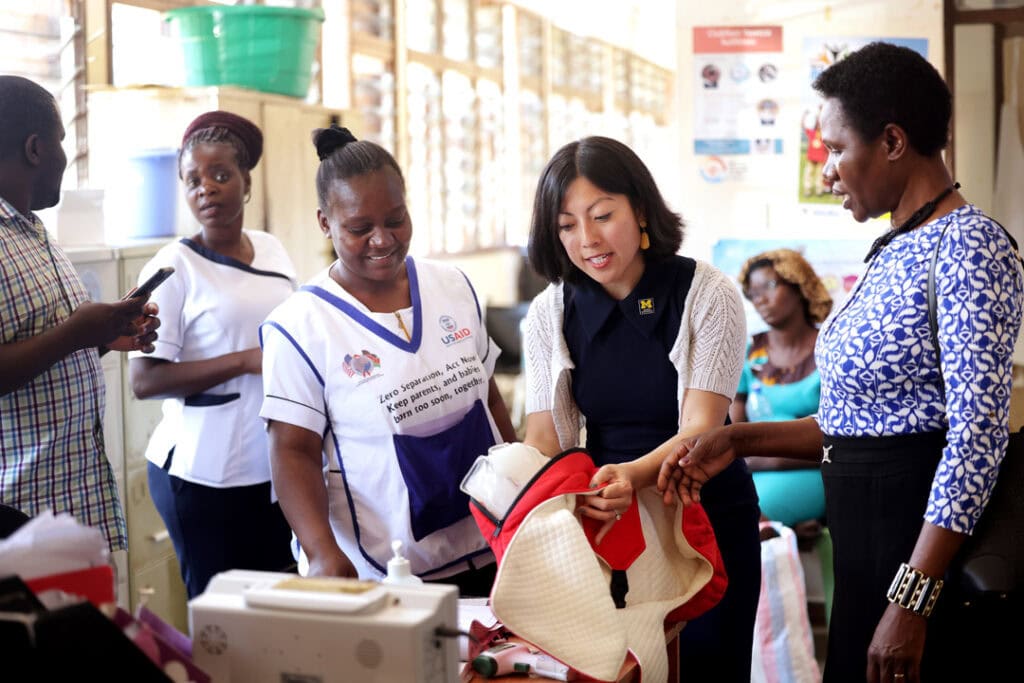
Otieno, who chooses to go by “Dr. Phelgona,” has been an essential medical advisor to Warmilu over the years, helping Hsia Haberl gain expertise in the maternal and neonatal health issues that underpin the company’s mission. The pair has also partnered on research and grant writing, turning the ideas that constantly bounce between them into new healthcare research and opportunities for babies, mothers, KEMRI and U-M. The two met through Otieno’s son, Ted Otieno, who studied entrepreneurship with his best friend Zach Hwang, a classmate with Hsia Haberl at U-M.
Where Hsia Haberl’s energy flows in a stream-of-consciousness barrage, Otieno’s seems to well up through the soles of her practical black leather shoes and fill her with confident, solid strength. She speaks when she has something to say. She talks slowly, clearly and quietly, and she knows you’ll listen.
“When I first started working with Dr. Phelgona, I was 25 years old,” Hsia Haberl said. “I had been running several programs from the U-M Economic Growth Institute, and I thought I was hot stuff. But there was this moment where she was introducing me to senior directors and CEOs of hospitals, head nurses and matrons, and I thought, ‘Oh no. I’m out of my depth.’
“But at that moment, I remember stepping up because Dr. Phelgona introduced me not just as her colleague, but as her friend. She saw something in me that I hadn’t until that day.”
Hsia Haberl calls the doctor a coach, advocate, partner, champion and second only to her mom as a superhero in her life. They are roles Otieno relishes, and for good reason.
“One of the things I’m personally interested in is mentorship, being able to stand there and say, ‘You can follow me,’” Otieno said. “I’m really proud of Grace, being so impactful at her age. You can see how people are amazed at her device, and I think if we’re able to roll it out in a way that most people can afford it, it could help revolutionize healthcare in this country.”
For Otieno, healthcare is about more than just health; it’s personal. Her work is a manifestation of her deep faith that a lifetime of positive energy poured into people, into research and now into Warmilu, will come back and multiply, rippling out into stronger communities and a more dynamic country.
“
A mother whose 500 gram baby survives is a mother who is forever, forever grateful.
“A mother whose pre-term survives is a different person than one whose pre-term has died,” she said. “A mother whose 500 gram baby survives is a mother who is forever, forever grateful. I’ve met mothers of pre-terms who survived who are now starting NGOs to bring other women together to help them.”
Like the small hospital where Adrian was born, power outages are common at JOOTRH. And as a larger facility, it receives babies referred from smaller hospitals and rural clinics.
A nurse requested a sample IncuBlanket some months ago but left the hospital soon after, and the integration of the devices sputtered. Because of Warmilu’s limited production capacity, Hsia Haberl feels strongly that every blanket should be warming babies every day, so she, Otieno and Chung have come to JOOTRH for an in-person training session. It’s one of many such presentations on the two-week trip, providing additional training and bringing IncuBlankets to prospective new users.
Hsia Haberl’s relentless energy along with the newness of the technology sometimes gives these meetings a touch of carnival atmosphere. Hsia Haberl always asks an audience member to feel the pack before activation to confirm it’s at room temperature and again after it’s activated. The warmth invariably triggers oohs and ahhs.
Otieno is the stoic yin to Hsia Haberl’s buzzing yang, putting the brakes on her frenetic pace when necessary, offering more detailed medical information, occasionally translating a phrase to Swahili. Over the years, she has played a big role in helping Warmilu tailor its products to African health systems and in helping Hsia Haberl adapt her full-throttle style to the soft-spoken Kenyan way.
Among the attendees, there’s a sense that the blankets could offer new ways to help premature infants and their families.
“We’ve made great strides toward providing more complete referral services, and the statistics tell us we are doing better,” said Lida Nyaoke, chief nursing officer at JOOTRH. “But we see the families who are afflicted when the transportation doesn’t go well, and at the end of the referral, the mother goes home without her child. We know that their loss is astronomical. So this is extremely good news.”
Love comes full circle
In Kehancha the following morning, Salome and Adrian are again on the road to the local hospital. This time she’s not bringing him for medical treatment. She’s bringing him to meet Hsia Haberl, who is in town to gather feedback about the hospital’s experience with IncuBlankets.
Warmilu has grown into a wide-ranging enterprise that generates opportunity at home and abroad, disseminates knowledge about science, manufacturing and entrepreneurship, and inspires students to bring their own ideas to fruition. But at its core is one goal: saving babies.
And yet, Hsia Haberl has never met a child who has benefited from one of the devices. She’s abuzz with excitement as the van enters the gates of the hospital. “This is just the most amazing day,” she whispers to herself.
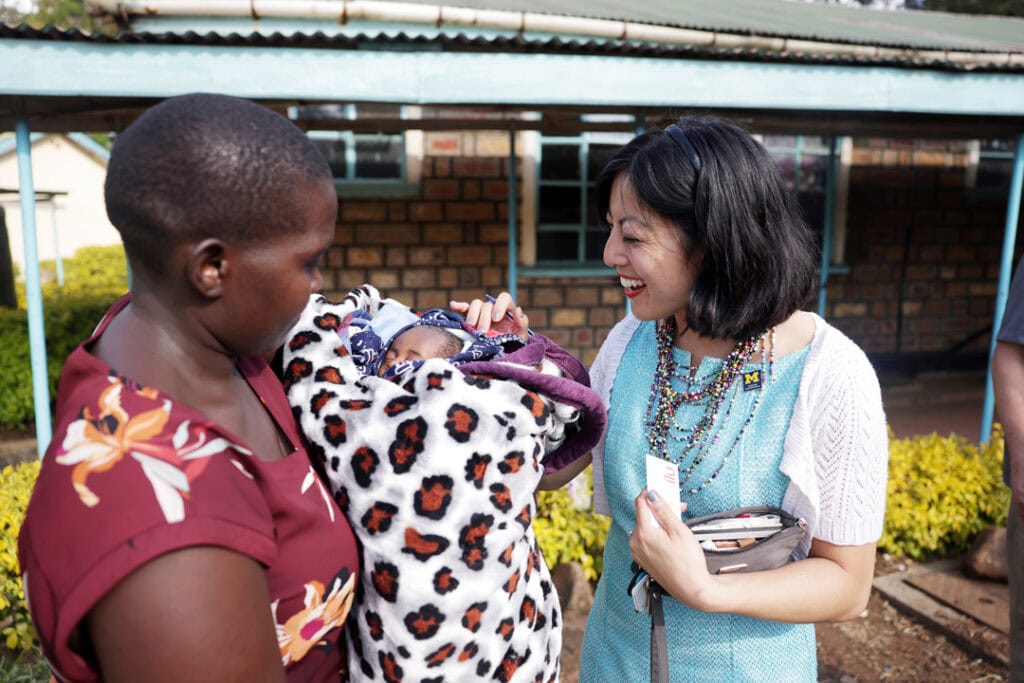
When Hsia Haberl arrives, Salome is sitting on a hospital bed, her close-cropped hair and hibiscus-print top lit by the sun streaming through the window behind her. Over her head are billows of somehow-festive cornflower blue mosquito netting. Adrian, in her arms, has decided to mark the occasion with a nap. His nose pokes out from a bundle of leopard-print fleece blankets.
“Hello Edna! Hello Adrian!” Hsia Haberl exclaims.
Kenyans tend to greet even new acquaintances like old friends, and Salome is no exception. She invites Hsia Haberl to sit next to her and meet Adrian up close. Hsia Haberl puts a hand on Adrian’s blanket.
As the women talk, she gives Salome some news she has been saving—just a few days before leaving Ann Arbor for Kenya, Hsia Haberl herself learned she was pregnant. Her journey has come full-circle in a way that even she never imagined when she sewed the blanket and sealed the pack that would eventually warm Adrian.
Salome congratulates Hsia Haberl and passes her son to the mother-to-be, the two women peering together at the tiny forehead and dozing eyes inside the blankets. Hsia Haberl wraps her arms around the bundle with a tearful mix of joy and disbelief.
“This is the energy that fuels another 12 years.”





